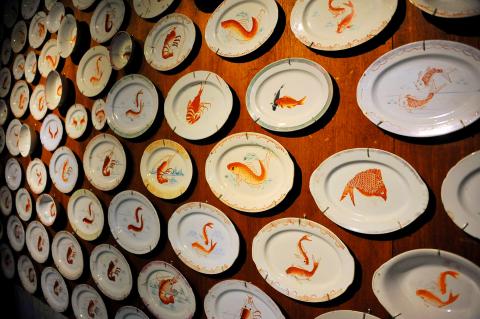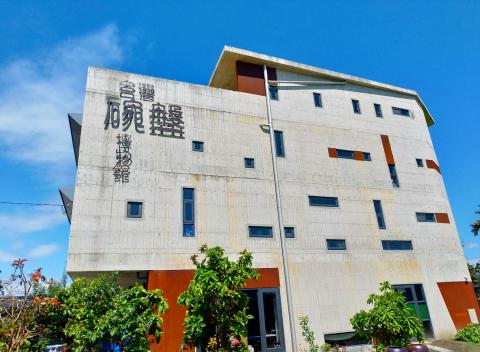Chien Yang-tung (簡楊同) had been collecting Chinese pottery for about five years when he came across his first Taiwanese piece about 20 years ago. It was a small dish adorned with hand-painted pink flowers produced in the pottery capital of Yingge (鶯歌) in the 1960s.
“It sent a shockwave through my body,” he says. “It was obviously distinct from what I had been collecting, yet it was so beautiful.”
His collection has grown so much that he is selling duplicates out of his stash of over 30,000 pieces in front of his Taiwan Bowl and Dish Museum (台灣碗盤博物館), which reopened to the public in a new beton brut-style building on April 21 in Chien’s hometown of Wujie Township (五結鄉), Yilan County. Originally located in nearby Yuanshan Township (員山), Chien closed the museum in December 2016 after its lease expired. Not all of the pieces survived the move across the Lanyang River (蘭陽溪), but Chien doesn’t seem to mind because no favorites were lost.

Photo: Han Cheung, Taipei Times
For the past year, Chien says he has been focused on the construction of the four-story concrete structure, in which just the permanent displays on the first two floors are available for viewing. It’s impressive enough with about 5,000 pieces on display, and Chien is looking to use the remaining two floors for special exhibitions.
While the old museum featured a number of pieces from China and Japan, the new permanent display mainly focuses on Taiwan-related wares, including a number of rare polychrome, hand-painted underglaze dishes that were only made from the end of World War II until mass production took over in the 1970s.
“I started out collecting Chinese ceramics and porcelain, and only later did I notice that Taiwanese ones had a distinct character to them,” Chien says. “Every culture in the world makes pottery, and it’s not easy to stand out from the pack.”

Photo courtesy of Taiwan Bowl and Dish Museum
MADE IN TAIWAN
Chien stares at a backless shelf full of bowls in front of a large glass window, with the lush rice paddies across the street providing a soothing background. However, he’s not pleased.
“Someone came and said the window is backlighting the wares, so I have to make adjustments,” he says.
Chien is holding off his grand opening indefinitely as he gathers feedback from visitors to optimize his permanent exhibition. There’s still much work to do, including adding individual labels to each piece as well as translating the detailed descriptions into English. Research is also in progress — there’s a section that highlights the manufacturers’ logos on the bottom of the wares, but Chien is still trying to figure out the identity of several who show only English initials such as “LCF” and “DF.”
Chien has been an avid treasure hunter — rare stamps, records, religious figurines — since he was young. He says he could always find something at flea markets while his friends came up empty-handed. But his love affair with pottery didn’t begin until China opened up in the late 1980s and Chinese porcelain wares became more accessible in Taiwan.
What was more of a hobby became a passion after that fateful encounter with his first Taiwanese dish two decades ago. Since the type of local ware he sought is relatively modern and were used as everyday objects, they weren’t hard to find — collectors, museums and academics paid little attention to them, preferring to focus on delicate and rare Chinese or Japanese antiques. Chien, who was born in 1964, grew up in the era of mass production but recalls seeing similar objects at banquets or temple festivals when he was younger.
“These bowls and dishes reflected Taiwanese society [after the war],” he says. “They were used by every household, rich or poor. I felt in them a sense of familiarity. They spoke to me,” he says.
Before he knew it, his collection ballooned. “That’s how collecting works,” he says. “It seems that objects know how to find their owners.”
Aborigines have been making pottery in Taiwan for 6,000 years, but they were fired in open pits instead of kilns. Han Chinese immigrants brought their expertise to the island, which developed unique characteristics over the centuries. Due to the lack of local kaolinite, the main ingredient in porcelain, Taiwanese produced stoneware, which is more opaque with grayer or browner tones depending on the clay used, Chien says.
Taiwanese wares bear much similarity to those produced in China’s Fujian province, where most Han Chinese immigrants hailed from. Chien says they are recognizable not only through the material but also by the pastel palette with lots of pink and muted colors, while Chinese products tend to favor bolder tones like vermilion red. Tropical motifs such as palm trees were popular in both southern China and Taiwan, but Chien says Chinese depictions of the trees are generally more slender and delicate. Taiwanese designs are warm and passionate, Chien says, not as bold as Chinese designs but fancier than Japan’s minimalist ethos.
“Taiwan’s problem is that the National Palace Museum [which mostly displays Chinese artefacts] had long-dominated the scene,” Chien says. “These local products were mostly ignored.”
LIMITED RELEASE
Of the Taiwanese products, Chien finds those produced from post World War II to the 1970s the most fascinating. Production increased because Taiwan didn’t trade with China, and around the same time polychrome underglaze techniques had matured enough for larger-scale production.
Many of these wares feature similar decorations as manufacturers would copy each other’s best-selling designs. For example, the museum shows an entire wall of dishes with red shrimp, fish and lobster illustrations — reflecting times where people were too poor to eat seafood regularly. These hand-drawn plates soon went out of fashion as mass production took off in the 1970s.
“This style did not exist before that period, and there won’t be any more made,” he says.
Of the non-Taiwanese pieces, Chien focuses on Zhangzhou wares (漳州窯), a city on the Fujian coast that became a key port of the maritime silk road during the Ming Dynasty. Since they were mainly exported, they were tailored for foreign buyers with Japanese and Arabic phrases and other unusual decorations. The Fujianese pirate Cheng Chih-lung (鄭芝龍) and his son Cheng Cheng-kung (鄭成功, also known as Koxinga) were prominent traders in the area, and the younger Cheng eventually established a kingdom around today’s Tainan area.
Don’t expect the museum to be complete anytime soon — Chien remains mum on when he will host his grand opening.
“Maybe when I finish my next building,” he says, pointing to an empty field next to the museum, adding that he may have found a new addiction in construction. “That may take another year.”

On April 26, The Lancet published a letter from two doctors at Taichung-based China Medical University Hospital (CMUH) warning that “Taiwan’s Health Care System is on the Brink of Collapse.” The authors said that “Years of policy inaction and mismanagement of resources have led to the National Health Insurance system operating under unsustainable conditions.” The pushback was immediate. Errors in the paper were quickly identified and publicized, to discredit the authors (the hospital apologized). CNA reported that CMUH said the letter described Taiwan in 2021 as having 62 nurses per 10,000 people, when the correct number was 78 nurses per 10,000

As we live longer, our risk of cognitive impairment is increasing. How can we delay the onset of symptoms? Do we have to give up every indulgence or can small changes make a difference? We asked neurologists for tips on how to keep our brains healthy for life. TAKE CARE OF YOUR HEALTH “All of the sensible things that apply to bodily health apply to brain health,” says Suzanne O’Sullivan, a consultant in neurology at the National Hospital for Neurology and Neurosurgery in London, and the author of The Age of Diagnosis. “When you’re 20, you can get away with absolute

May 5 to May 11 What started out as friction between Taiwanese students at Taichung First High School and a Japanese head cook escalated dramatically over the first two weeks of May 1927. It began on April 30 when the cook’s wife knew that lotus starch used in that night’s dinner had rat feces in it, but failed to inform staff until the meal was already prepared. The students believed that her silence was intentional, and filed a complaint. The school’s Japanese administrators sided with the cook’s family, dismissing the students as troublemakers and clamping down on their freedoms — with

As Donald Trump’s executive order in March led to the shuttering of Voice of America (VOA) — the global broadcaster whose roots date back to the fight against Nazi propaganda — he quickly attracted support from figures not used to aligning themselves with any US administration. Trump had ordered the US Agency for Global Media, the federal agency that funds VOA and other groups promoting independent journalism overseas, to be “eliminated to the maximum extent consistent with applicable law.” The decision suddenly halted programming in 49 languages to more than 425 million people. In Moscow, Margarita Simonyan, the hardline editor-in-chief of the